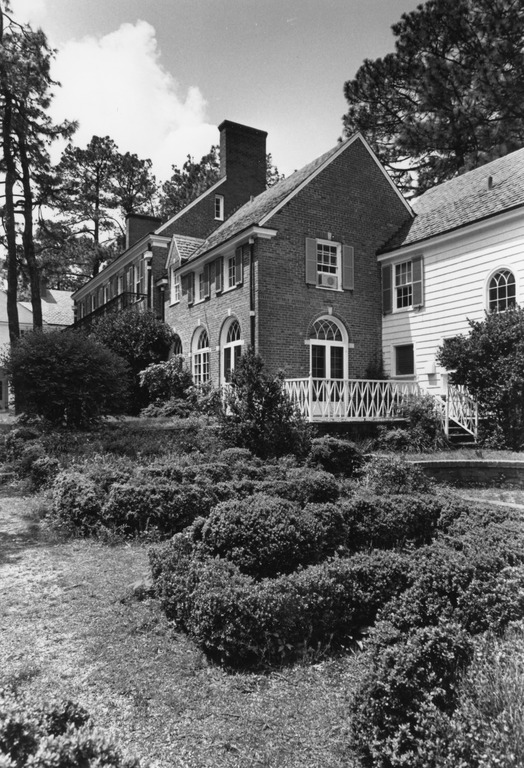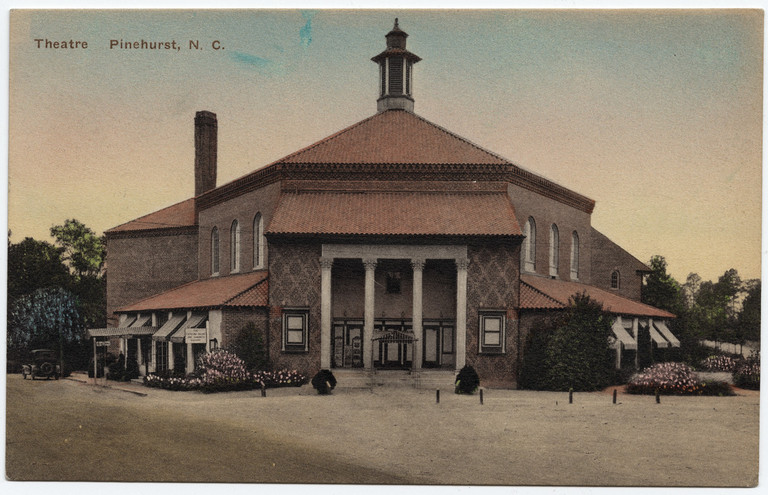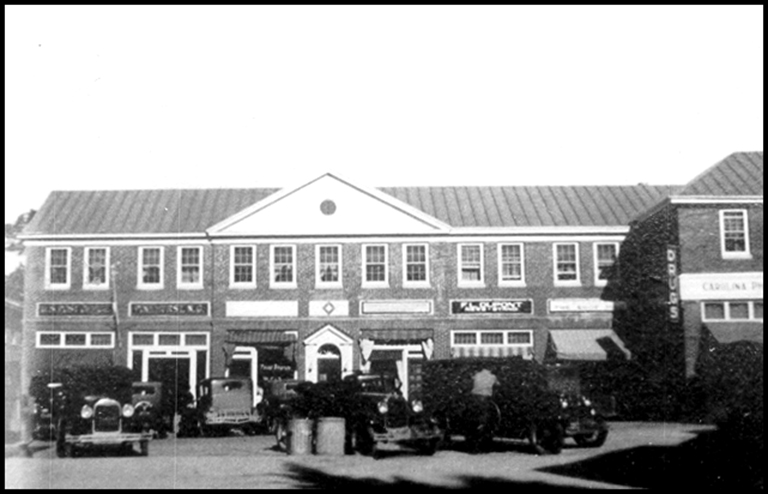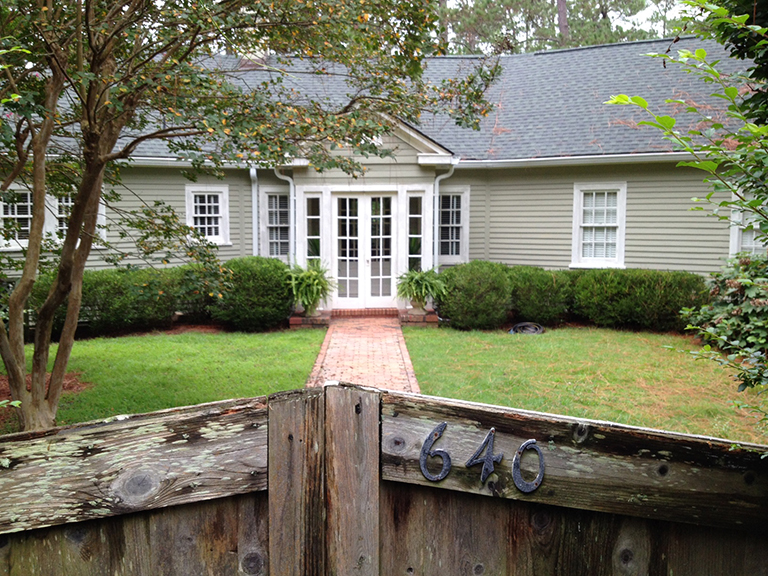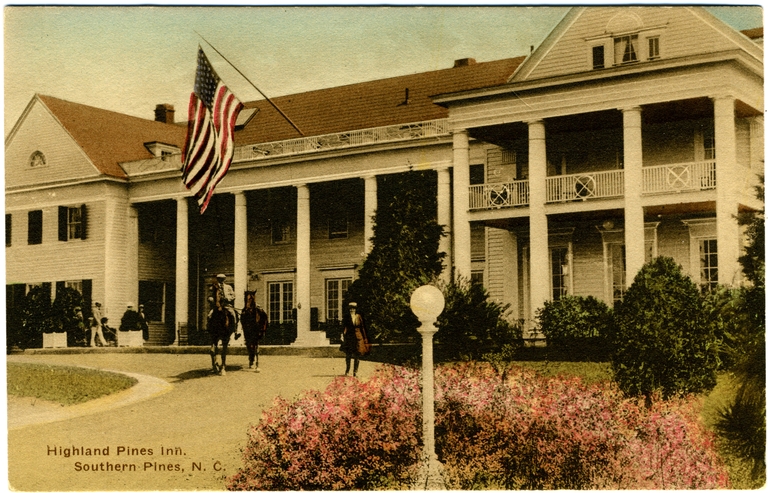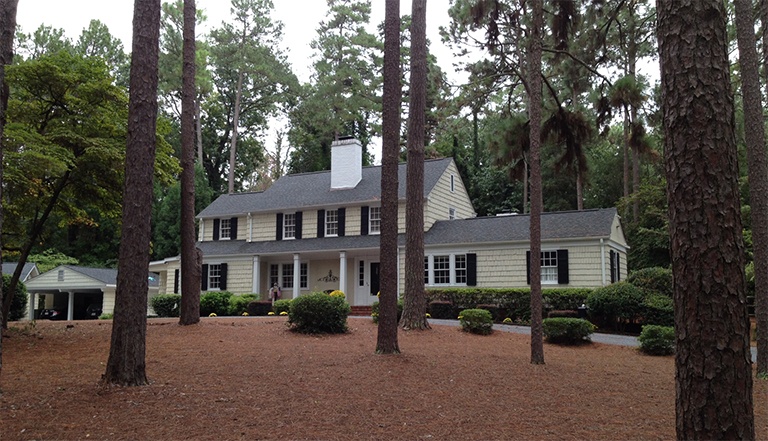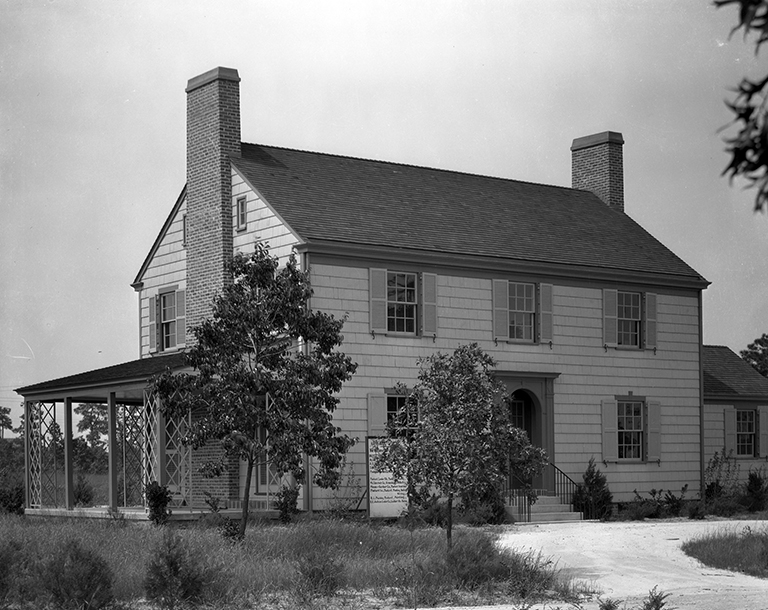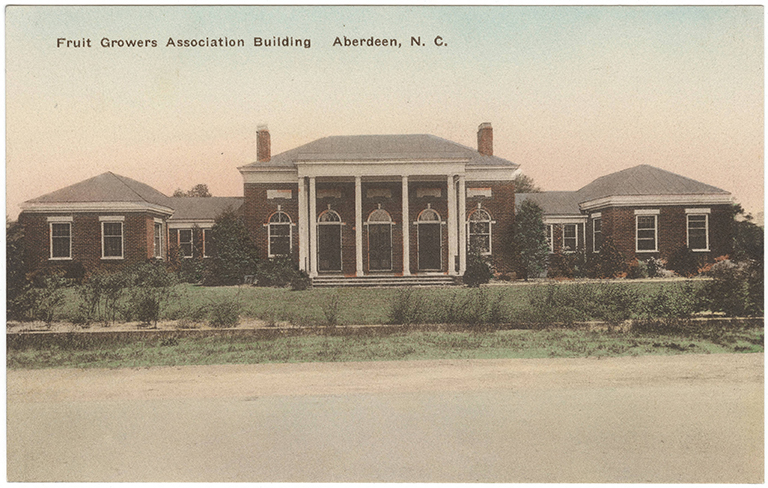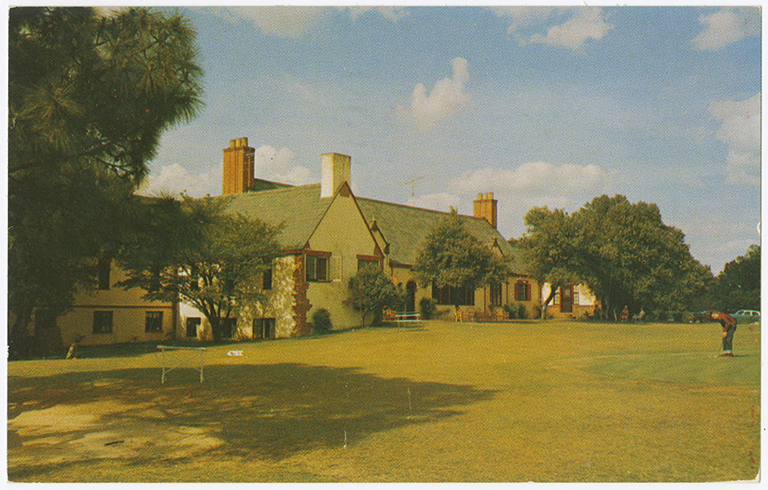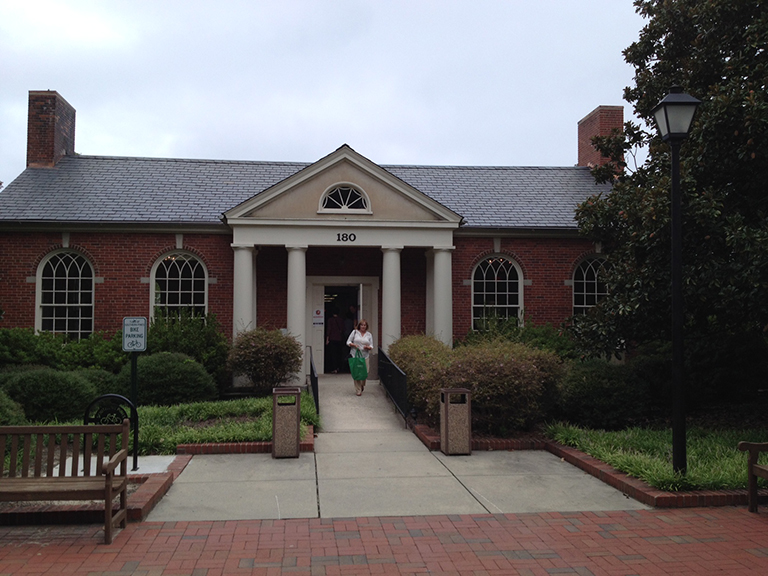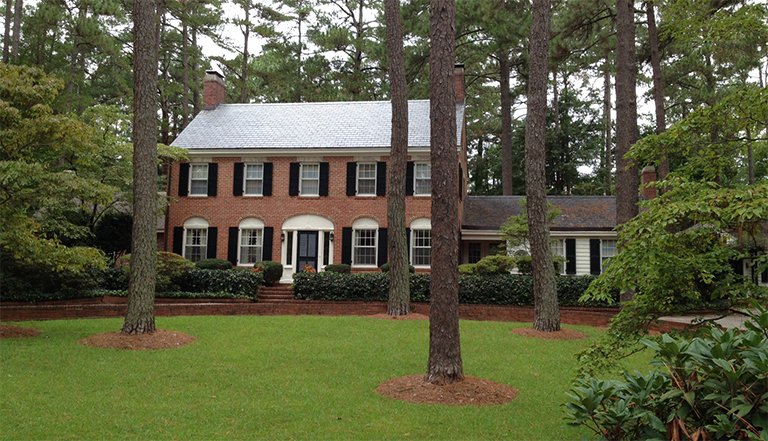Embury, Aymar II (1880-1966)
Birthplace:
New York City, New York, USA
Residences:
- New York City, New York
Trades:
- Architect
Building Types:
Styles & Forms:
Colonial Revival; Georgian Revival; Tudor Revival
Aymar Embury II (1880-1966), a New York architect known for his country houses and country clubs of the early to mid-twentieth century as well as bridges and other public works in New York, created in North Carolina a distinctive and eclectic body of architecture that helped define the unique character of the Sand Hills resort communities including especially Pinehurst and Southern Pines. The local newspapers gave extensive and laudatory coverage to Embury’s work in the area, reporting frequently on buildings he designed. The Moore County News of April 27, 1922, noted several Embury projects and commented, “Embury has set his sign manual so persistently on Weymouth Heights [in Southern Pines], as well as on Knollwood and Pinehurst that the Sandhills country is becoming an Embury dream.” An article about his work in the Sand Hills in Architectural Record, June 1924, observed that his buildings there employed styles drawn from Colonial and English traditions “with a freedom and informality that are characteristic of all of Mr. Embury’s work, but with a distinct (if undefinable) local flavor.”
Born in New York City, Embury was graduated from Princeton University in 1900 with a degree in engineering, received his master’s degree from the same institution in 1901, and began practicing architecture in New York in that year. As related in the finding guide to his papers at Syracuse University Libraries, Embury taught architecture at Princeton while working for various architectural firms in New York. During World War I he served as a captain with the 40th Engineers of the United States Army, and he designed the Army Distinguished Service Medal and Distinguished Service Cross. Embury’s architectural practice encompassed a range of building types, including clubs, country houses, hotels, libraries, and college buildings including those at Princeton, Kalamazoo College, and Hofstra College. Especially noteworthy was his work with New York Parks Commissioner Robert Moses, as part of a team that designed and executed more than 600 projects for the city of New York, including numerous bridges, the Lincoln Tunnel, and the Port of New York Authority Terminal Building. He was also the architect for the New York City and Argentine Pavilions at the 1939 World’s Fair in New York. Like other architects of his generation, he made a study of historic architecture, which honed his skills in using colonial and other historical motifs in his own designs. He wrote several books, including 100 Country Houses (1901), The Dutch Colonial House (1911), Country Houses (1914), Early American Churches (1914), The Liveable House (1917), and The Esthetics of Engineering Construction (1943). Notable for North Carolina was his volume on historic architecture in New Bern for the White Pine series.
Although Embury’s practice focused in the northeastern and mid-Atlantic United States, he created a significant body of work in North Carolina, chiefly in Moore County in the Sand Hills region, a thinly settled area which in the late nineteenth century had become home to the resort communities of Southern Pines and Pinehurst. The temperate weather, relatively dry air, and supposedly healthful aura of the pines attracted northern investors, developers, visitors, and residents. In time the area, especially Pinehurst, became a nationally renowned golf mecca, while in Southern Pines fox hunting and other equestrian sports were popular. The developers of both communities created planned towns, and they and the residents of the communities employed various northern architects to design buildings of a sophistication previously unknown in the locale.
Much of Embury’s work concentrated in Southern Pines, to which he was introduced by fellow Princeton graduate James Boyd. The grid-plan town was begun as a health resort for northerners after the railroad arrived in 1877, and it grew slowly until the 1890s, when the focus shifted to recreation. By 1910 it had a collection of residences and hotels in a variety of styles. When the popular Piney Woods Inn burned in 1910, resident author and property owner James Boyd provided a tract at the south end of Massachusetts Avenue for a new hotel—the project that brought the young Embury to the area. His large, frame Colonial Revival style Highland Pines Inn opened in 1912 and featured capacious porches punctuated by gabled pavilions. The grounds were planned by Alfred Yeomans, a landscape architect from Chicago and a Boyd relative. Embury also designed several Colonial Revival style Highland Pines Cottages to be built near the hotel and rented under its management. This prestigious project was the beginning of a long period of work for Embury during a prime development era for the Sand Hills resort communities.
According to “Some Work of Aymar Embury II in the Sand Hills of North Carolina,” by Russell J. Whitehead (Architectural Record, June 1924), when Embury did his first work in the area in 1911, he used simple designs employing local materials for reasons of cost and also “because local labor could be depended upon to execute only the type of construction to which it was accustomed.” Entering a world long dominated by vernacular building traditions, he found that some local contractors “had never seen a blue print, or built from plans, and full sized details were unknown. These men, however, were eager to learn and quick to take suggestions and among them there are today [1924] many mechanics who can read plans intelligently and execute them well.”
Embury’s architectural and personal style suited Boyd and the prosperous, typically northern people who created the leisurely lifestyle of Southern Pines, and he did much to shape the architectural character of the community. He employed an eclectic vocabulary of revivalist styles, including the Georgian Revival and various English and French-inspired modes that he and his clients saw as suitable to the picturesque setting, temperate clime, and sociable lifestyle. He frequently used a linear floor plan organized around a large, central living room with views of both the entrance front and the rear garden that integrated indoor and outdoor living. Among his best known residential works in Southern Pines is Weymouth (ca. 1904, 1920s), a red brick and frame Georgian Revival house with a zoned, linear plan to accommodate author James Boyd’s literary and equestrian social circles. For Boyd’s aunt, Mrs. A. P. L. Dull, Embury designed a luxurious and eclectic English and French inspired residence called Loblolly (1918, 1928). After a downtown fire in 1921, Embury designed new brick commercial and institutional including the post office and a doctor’s office. He also planned several other residences in Southern Pines, as well as the Southern Pines Country Club as the centerpiece of a highly regarded golf course.
Likewise during the 1920s, Embury engaged in projects for clients in nearby Pinehurst, the curvilinear model resort village designed for Bostonian James W. Tufts by Frederick Law Olmsted, where his work appears alongside that of other architects including Hobart Upjohn of New York and the firm of Rand and Taylor, Kendall and Stevens of Boston. He designed two commercial blocks and the Carolina Theater (1921-1922) at the heart of Pinehurst along with several residences—including a 1925 model home, the “Ideal House”—chiefly in Colonial Revival modes with wood-shingled exterior walls compatible with the New England image of the town. Embury wrote of the community in the Pinehurst Outlook of December 10, 1932, that it was “singularly fortunate in having not only a few buildings of outstanding merit, but in having practically nothing Pinehurst that is offensive architecturally, so that. . . no matter where one turns, one feels that the community possesses good taste, and demands an agreeable background to the business of living.”
Other Embury projects in the Sand Hills included red brick, Georgian Revival style edifices in the railroad town of Aberdeen such as the Aberdeen High School and the Sand Hill Fruit Growers’ Association Building. Embury also designed in the 1920s the Mid-Pines Country Club at the new Tufts family development called Knollwood a few miles outside Pinehurst. The formal, expansive Georgian Revival style clubhouse was the center of a golf course planned by the famed golf course designer Donald Ross. This combination of a large and handsome clubhouse with a professionally designed course was a popular model for country clubs for many years to come; as a specialist in such facilities, Embury attracted elite North Carolina clients outside the locale, including the Charlotte Country Club and the Hope Valley Country Club near Durham. Although Embury continued to practice until the mid-1950s, there are no known post-World War II examples of his work in North Carolina.
According to Embury’s obituary in the New York Times of November 15, 1966, he was survived by his third wife, the former Jane Schabbehar, and three children, including his son Edward, with whom he had practiced architecture for several years. The Times reported that Embury had retired from active practice about ten years earlier but “had continued as a consultant to his firm here, now headed by his son, Edward Coe Embury.” The Times article noted that Embury sometimes “showed little patience with modernists” and quoted his comment in an 1938 interview: “Modernists. . . believe that the essence of their work is to do something that has never been done before. They leave off all ornamentation because, they say, the ornaments do not aid the structure to do its job. I suppose some of these architects do not use neckties or buttons when they dress.”
Syracuse University Libraries holds an extensive collection of Embury’s papers. The finding guide to the collection lists photographs or other records for the following North Carolina projects: Boyd house, Cady residence, Charlotte Country Club, Dull residence, Highland Pines Inn, Hope Valley Country Club, Mid-Pines Country Club, Dr. Mudgett Office, Post Office (Southern Pines), John Prisher residence, Southern Pines Country Club, Way Residence, and Woodstock. The building list in this entry includes only a portion of his total work in the Sandhills.
- David R. Black, “Southern Pines Historic District,” National Register of Historic Places nomination (1991).
- Aymar Embury II Papers, Special Collections Research Center, Syracuse University Libraries, Syracuse, New York.
- Davyd Foard Hood and Laura A. W. Phillips, Pinehurst Historic District National Historic Landmark Designation Report (1995).
- Clifford C. Wendehack, Golf and Country Clubs (1929).
- Russell J. Whitehead, “Some Work of Aymar Embury II in the Sand Hills of North Carolina,” Architetural Record (1924).
Aberdeen High School
Contributors:Aymar Embury II, architectDates:early 1920s
Location:Aberdeen, Moore CountyStreet Address:Aberdeen, NC
Status:Unknown
Type:Educational
Images Published In:Architectural Record (June 1924).
Note:The large 2-story red brick school building featured an imposing full-height portico between projecting end pavilions.
Boyd-Turner House
Contributors:Aymar Embury II, architectDates:1912-1913
Location:Southern Pines, Moore CountyStreet Address:660 E. Massachusetts Ave., Southern Pines, NC
Status:Standing
Type:Residential
Images Published In:Henry H. Saylor, Country Houses by Aymar Embury II (1914).
Note:The 2-story frame, Colonial Revival residence was built for the Boyd family to house the manager of the Highland Pines Inn. It was pictured in Country Houses by Aymar Embury II (1914).
Carolina Theater
Contributors:Aymar Embury II, architectDates:1921-1922
Location:Pinehurst, Moore CountyStreet Address:90 Cherokee Rd., Pinehurst, NC
Status:Standing
Type:Commercial
Note:The hexagonal brick building with green tile roof displays a Byzantine mode that contrasts with the prevalent colonial and Anglophilic styles in central Pinehurst.
Charlotte Country Club
Contributors:Aymar Embury II, architectDates:1931
Location:Charlotte, Mecklenburg CountyStreet Address:2465 Mecklenburg Dr., Charlotte, NC
Status:Standing
Type:Recreational
Note:A notable example of the type of country club Embury helped develop, with a formal clubhouse and professionally designed golf course, the complex includes his white-columned clubhouse evoking an “old South” image.
Citizens Bank and Trust Building
Contributors:Aymar Embury II, architectDates:1925
Location:Southern Pines, Moore CountyStreet Address:132 NW Broad St., Southern Pines, NC
Status:Standing
Type:Commercial
Clifton Chambers
Contributors:Aymar Embury II, architectDates:1922-1923
Location:Pinehurst, Moore CountyStreet Address:Market Square, Pinehurst, NC
Status:Standing
Type:Commercial
Note:The 2-story red brick building features the Colonial Revival detailing akin to other structures in downtown Pinehurst. The Pinehurst Outlook of Nov. 1, 1922 announced plans to build this structure and the nearby Market Square as part of a rebuilding of downtown.
Dr. E. E. Cady House
Contributors:Aymar Embury II, architectVariant Name(s):Cady House
Dates:ca. 1920
Location:Southern Pines, Moore CountyStreet Address:220 S. Valley Rd., Southern Pines, NC
Status:Standing
Type:Residential
Images Published In:Architectural Record (June 1924).
Note:Embury’s plan for the 1 1/2-story frame residence featured a broad terrace opening directly into a large living room, which overlooks the rear garden.
Dr. W. C. Mudgett Medical Office Building
Contributors:Aymar Embury II, architectDates:1923
Location:Southern Pines, Moore CountyStreet Address:140 SW Broad St., Southern Pines, NC
Status:Standing
Type:Health Care
Images Published In:Architectural Record (June 1924).
Note:The 2-story, red brick building features Colonial Revival details that made it to Whitehead “a charming piece of block front architecture’ which embodied the ideal qualities of the professional man, “modesty, ability, rectitude.”
Highland Pines Cottage
Contributors:Aymar Embury II, architectDates:1913
Location:Southern Pines, Moore CountyStreet Address:640 E. Massachusetts Ave., Southern Pines, NC
Status:Standing
Type:Residential
Images Published In:Henry H. Saylor, Country Houses by Aymar Embury II (1914).
Note:This is one of several cottages of 1912-1913 planned by Embury as part of the development around the Highland Pines Inn. It was illustrated in Country Houses by Aymar Embury II (1914). Other examples include the houses at 350 Highland Rd. and 305 Highland Rd.
Highland Pines Inn
Contributors:Aymar Embury II, architectVariant Name(s):Highland Pines Hotel
Dates:1911-1912
Location:Southern Pines, Moore CountyStreet Address:E. Massachusetts Ave., Southern Pines, NC
Status:No longer standing
Type:Commercial
Note:The large, T-plan Colonial Revival hotel, opened in 1912 as a project of James Boyd, was the first of many projects for Embury in the Sand Hills. It reportedly burned in 1957.
Hope Valley Country Club
Contributors:Aymar Embury II, architect; Milburn and Heister, supervising architectsDates:1927
Location:Durham, Durham CountyStreet Address:3803 Dover Rd., Durham, NC
Status:Altered
Type:Recreational
Note:The picturesque clubhouse and associated Donald Ross golf course are part of an elite suburban development established in the 1920s. The clubhouse has been expanded several times. Embury is also credited with designing the classically detailed entrance gates.
Hugh Batterley House
Contributors:Aymar Embury II, architectVariant Name(s):Betterley House
Dates:ca. 1920
Location:Southern Pines, Moore CountyStreet Address:210 S. Valley Rd., Southern Pines, NC
Status:Standing
Type:Residential
Note:The 2-story frame house featured a central chimney and shingled exterior walls, while the plan repeated Embury’s central living room opening directly to the outdoors.
Ideal House
Contributors:Aymar Embury II, architect; A. B. Sally, contractorDates:1925
Location:Pinehurst, Moore CountyStreet Address:55 Midland Dr., Pinehurst, NC
Status:Standing
Type:Residential
Note:According to the Pinehurst National Historic Landmark report, the 2-story, wood-shingled house of Colonial Revival style was built in 1925 as an “ideal house” in Pinehurst to showcase “the type and quality of work that could be achieved locally. Various trade and building concerns active in and about Pinehurst erected the house in a cooperative venture. The house remained open for public viewing during the 1925-1926 season and was then sold to J. Frank Black.” It was also known as “Nandina.”
James Barber House
Contributors:Aymar Embury II, architectDates:ca. 1920
Location:Knollwood, Moore CountyStreet Address:Knollwood, NC
Status:Altered
Type:Residential
Images Published In:Architectural Record (June 1924).
Note:One of several two-story Colonial Revival houses planned by Embury, it has a compact plan described by Whitehead in Architectural Record, June 1924, as a “miracle of economy. To get five large bedrooms, three baths, and ample closets on a floor of this size is a triumph of planning, and it will be found if the plans are studied that all rooms are corner rooms or have cross drafts, and that in all the principal rooms symmetry has been maintained with the utmost care, and yet with an appearance of ease that every architect knows to be deceptive.”
Loblolly
Contributors:Aymar Embury II, architect; John A. McPherson, contractorVariant Name(s):Mrs. A. P. L. Dull House
Dates:1918; 1928
Location:Southern Pines, Moore CountyStreet Address:140 N. Valley Rd., Southern Pines, NC
Status:Standing
Type:Residential
Images Published In:Architectural Record (June 1924).
Note:The picturesque residence combines English and French motifs in vivid masonry work. Whitehead praised it highly in Architectural Record, June 1924, for being “playful in the use of material, without affectation. . . . It is clever without being tricky, gay and insouciant without lacking dignity.” Like Embury’s other houses in the Sand Hills, Whitehead wrote, it is a “logical expression of the plan,” while its hues of sand gray, red brick, and gray brown woodwork “are absolutely in harmony with the sandy soil and the green of the pines.” Loblolly suffered from a fire in 1926 and was rebuilt in 1928.
Market Square Block
Contributors:Aymar Embury II, architectDates:1922-1923
Location:Pinehurst, Moore CountyStreet Address:Market Square, Pinehurst, NC
Status:Standing
Type:Commercial
Images Published In:Architectural Record (June 1924).
Note:The 2-story, red brick commercial building features Colonial Revival details and multiple window and door shapes for a multi-use structure.
Mid-Pines Country Club
Contributors:Aymar Embury II, architectDates:1920s
Location:Knollwood, Moore CountyStreet Address:1010 Midland Rd., Knollwood, NC
Status:Altered
Type:Recreational
Note:The large mass of the 3-story, Georgian Revival style country club is broken up into a long central section flanked by angled wings with porticoes on the entrance front and pedimented pavilions on the golf course side. When completed it had a hundred bedrooms and a hundred bathrooms, plus servants’ rooms.
Pushee House
Contributors:Aymar Embury II, architectVariant Name(s):Twin Gables
Dates:1914
Location:Southern Pines, Moore CountyStreet Address:605 E. Massachusetts Ave., Southern Pines, NC
Status:Standing
Type:Residential
Sand Hills Fruit Growers Association Building
Contributors:Aymar Embury II, architectDates:early 1920s
Location:Aberdeen, Moore CountyStreet Address:Aberdeen, NC
Status:No longer standing
Type:Commercial
Images Published In:Architectural Record (June 1924).
Southern Pines Country Club
Contributors:Aymar Embury II, architectDates:ca. 1920
Location:Southern Pines, Moore CountyStreet Address:Southern Pines vicinity, NC
Status:No longer standing
Type:Recreational
Images Published In:Architectural Record (June 1924).
Note:As Russell Whitehead pointed out in Architectural Record, June 1924, Embury met the challenge of planning a relatively small country club on a then barren site by creating what Whitehead considered “the loveliest small clubhouse in America.” The multi-gabled, 1 1/2-story masonry building had a “lovely color scheme which gives to the club an air of joyousness,” including the sandy buff stuccoed walls, accents of sandstone and red brick, and “amusing” metal cornices, doors, and other elements in blues and greens. How long it continued in use remains to be determined.
Southern Pines Public Library
Contributors:Aymar Embury II, architectDates:1939
Location:Southern Pines, Moore CountyStreet Address:180 SW Broad St., Southern Pines, NC
Status:Standing
Type:Public
Southern Pines Public School
Contributors:Aymar Embury II, architectDates:ca. 1920
Location:Southern Pines, Moore CountyStreet Address:May St., Southern Pines, NC
Status:Altered
Type:Educational
Images Published In:Architectural Record (June 1924).
Note:The public school incorporated the red brick Georgian Revival style favored by Embury and his clients. Whitehead commented that in his public schools in the Sand Hills, Embury avoided the “factory-like look” of most public schools and produced buildings that gave the pupils “a daily object lesson in good architecture.”
Southern Pines United States Post Office
Contributors:Aymar Embury II, architectVariant Name(s):United States Post Office, Southern Pines
Dates:1937
Location:Southern Pines, Moore CountyStreet Address:190 SW Broad St., Southern Pines, NC
Status:Standing
Type:Public
Way Cottage
Contributors:Aymar Embury II, architectDates:ca. 1920
Location:Knollwood, Moore CountyStreet Address:Knollwood, NC
Status:Standing
Type:Residential
Images Published In:Architectural Record (June 1924).
Note:Whitehead stated in Architectural Record, June 1924, that Richard Tufts, developer of the Mid-Pines club at Knollwood, was the “architect” of the 1 1/2-story “cottage” which was “intended for winter use only” and made use of stock moldings from catalogs.
Weymouth
Contributors:Aymar Embury II, architectVariant Name(s):James Boyd House
Dates:ca. 1904; 1920s
Location:Southern Pines, Moore CountyStreet Address:E. Vermont Ave. Ext., Southern Pines, NC
Status:Standing
Type:Residential
Images Published In:Architectural Record (June 1924).
Note:Incorporating an existing house owned by Boyd’s grandfather, Embury designed an asymmetrical Georgian Revival house with a linear plan open to the outdoors. Typical of several of his houses in the area, the piazza opens into a very large living room that overlooks the rear garden. In the Architectural Record, June 1924, Whitehead called it “a lovely, loosely connected, informal sort of enlarged Colonial farm house,” in which the plan was created from Boyd’s own sketches and the exterior form developed from that plan.
Woodstock
Contributors:Aymar Embury II, architectDates:ca. 1920
Location:Southern Pines, Moore CountyStreet Address:120 Highland Rd., Southern Pines, NC
Status:Standing
Type:Residential
Images Published In:Architectural Record (June 1924).
Note:A compactly planned 2-story Georgian Revival house, which Whitehead said had a New England flavor. It was built by the Boyd family as an investment property in an area called Weymouth Heights.

